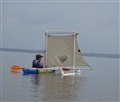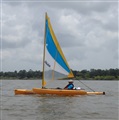Sailing across Lake Anahuac
July 21st, 2013
by Natalie Wiest
Nine optimistic folks were up to the challenge of finding new and innovative, or even tried and true, methods of sailing canoes and kayaks across Lake Anahuac and Sunday morning, July 21, 2013, we duly set sail across the lake.
| |
 |
| |
Natalie's "two sticks" |
My “tried and true” method was the most primitive, two sticks stuck in a plastic shelf base and tied up to the canoe thwart, with a 2-pocket rectangular sail atop all. I’d used this once before and it worked OK – not the fastest, but it can be effective. Only problem at this particular start – no wind and this photo shows the sail filling in the wrong direction. It was getting plenty warm out there on the open lake and we were all a bit chagrined at the non-wind at the start although things did pick up a bit later.
 |
|
| Terry's plaid sails |
|
Harmon and Terry had matching plaid sails but two slightly different designs. We loved their cute outriggers which worked just fine. Here’s Terry at the putin.
Her comment on this rig: “We arrived early to the put in. Upon setting up, I realized that my boom was longer than the sails stays. We had shortened the boom once earlier on. Not setting up the sails the evening before, I failed to remember that Harmon also shortened the outriggers. My sail was too long from mast to the end of the boom even though I had put a dart in center. 50 feet from shore I had to go back and re-rig my sail and connect the end of the boom to the top of the mast for the boom was falling in the water.
"Now I am back in the water, there is no wind to speak of. The paddle I generally use for paddling was too long with the outrigger positioned where it was behind the seat. I kept hitting the mast stays, the outrigger floats. The stroke of the paddle had to change to a short shallow stroke.
"The winds did come up along with the waves and off I went, but much slower than everyone else. The sail was working but the rudder was not. I had to constantly use my paddle to rudder as the wind was much stronger than my short stocky stroke to attempt to keep the kayak tacking in the direction of the lunch stop. I was moving but not always in the direction I was supposed to go.
| |
 |
| |
Harmon's sail |
"Sailing was not bad as the wind was up. We turned into the bayou and there was no wind. My short stocky paddle stroke for the next 2 mi was wearing on my elbow and arms. I would say with a few adjustments before the next outing then all may be great. I want to thank Harmon for taking a few of my ideas along with his and making this an experience that could be doable.“
Note the slightly different configuration of Harmon’s sail, which he seemed quite happy with but I believe his redesign may feature a larger sail area.
 |
|
 |
|
| Steve's design |
|
Cindy's rig |
|
Steve had an even different design for his kayak, plans he borrowed from the Web. This design seemed to work quite well.
He and Cindy were able to take advantage of designed–in rudders for steering their kayaks under sail. Here’s Cindy’s rig, a commercially available sail with a very clever design. This is a “Wind Paddle” sail.
| |
 |
| |
Joe's entry |
Joe was a last-minute entry, but also a clever design that featured the wing of a model airplane that his son had left unprotected. I like the Bedouin-style sun protection as well.
 |
|
| Paul's craft |
|
Paul did some very interesting construction to put his craft together, featuring one of the largest sail areas. However, a modest design flaw soon had that big outrigger pipe sinking into the lake. We limp/floated to the edge of the lake and rerigged so that Paul and I became a catamaran, our two boats (canoe and kayak) tied together by the crossmembers with my canoe now being the giant outrigger. All went well until after our lunch break (when we actually had so much wind on the lake there were whitecaps!) and wave action further destroyed the connective abilities of PVC glue. By the time we got up Turtle Bayou to the takeout at White’s Park, Paul’s rig was pretty much de-constructed.
| |
 |
| |
Dave's Hobie |
Dave had the most efficient of the sailing rigs, the commercial rigging of Hobie, and he just flew around, sailing circles around the rest of us whenever there was wind. Here he is.
Of course we now wish to have a rematch, and you’re welcome to join us too. Well, sometime when we can count on prevailing southerly winds (for people like me who really can’t tack). Wouldn’t you like to join us?
 |
| The author, Natalie Wiest |